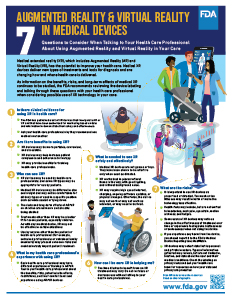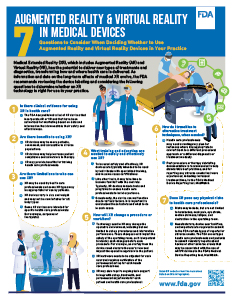Augmented Reality and Virtual Reality Medical Devices: Questions to Consider
If you’re a patient, caregiver, or health care professional considering using Augmented Reality (AR) or Virtual Reality (VR) in your health care or practice, the U.S. Food and Drug Administration (FDA) developed these infographics to help you weigh some of the benefits and risks and make an informed decision before using AR or VR medical devices.
Medical extended reality (XR), which includes AR and VR, has the potential to improve your health care, delivering new types of treatments and tools for diagnosis and treatment of health conditions. Treatments may range from neurology to orthopedics to radiology and more. Medical XR may help advance health equity by providing care at home, outside of the hospital or when a specialist is not locally available. As information on the benefits and risks, including the long-term effects, of medical XR are continuing to be studied, the FDA recommends the following questions for you to consider when deciding whether to use XR technology:
For Patients
Download the Poster (Web and PDF):
Digital Version
(2.04 MB) 8.5" x 11"
(2.28 MB) 11" x 17"
(2.41 MB)
For Health Care Professionals
Download the Poster (Digital and PDF):
Digital Version
(2.01 MB) 8.5" x 11"
(958 KB) 11" x 17"
(869 KB)
FDA Resources About XR
| Resources | Description |
| List of Medical Devices that Incorporate XR (including AR/VR) | This is a list of medical devices that incorporate AR/VR marketed in the United States. |
| Medical Device Reporting (MDR): How to Report Medical Device Problems |
The FDA encourages patients and health care professionals to report any adverse events that were experienced while using the AR/VR device to the FDA’s Medical Device Reporting tool, MedWatch. |
| FDA’s Manufacturer and User Facility Device Experience (MAUDE) | The MAUDE database houses MDRs submitted to the FDA by mandatory reporters such as manufacturers, importers and device user facilities and voluntary reporters such as health care professionals, patients and consumers. |
| Medical Extended Reality Program: Research on Medical Extended Reality-Based Medical Devices | The Medical Extended Reality Program conducts regulatory science research to help ensure patient access to innovative extended reality-based devices that are safe and effective. |
| Artificial Intelligence and Machine Learning Program: Research on AI/ML-Based Medical Devices | The Artificial Intelligence and Machine Learning (AI/ML) Program in the FDA’s Center for Devices and Radiological Health (CDRH) conducts regulatory science research to ensure patient access to safe and effective medical devices using AI/ML. |
Augmented Reality & Virtual Reality in Medical Devices: 7 Questions to Consider When Talking to Your Health Care Professional About Using Augmented Reality and Virtual Reality in Your Care
Medical extended reality (XR), which includes Augmented Reality (AR) and Virtual Reality (VR), has the potential to improve your health care. Medical XR devices deliver new types of treatments and tools for diagnosis and are changing how and where health care is delivered.
As information on the benefits, risks, and long-term effects of medical XR continues to be studied, the FDA recommends reviewing the device labeling and talking through these questions with your health care professional when considering possible use of XR technology in your care.
1. Is there clinical evidence for using XR in health care?
- The FDA has published a list of XR devices that incorporate AR or VR and that have been authorized for marketing based on data and information to demonstrate their safety and effectiveness.
- Ask your health care professional why they recommend one method over another.
2. Are there benefits to using XR?
- XR devices may be more portable, convenient, and accessible.
- XR devices may help increase patient compliance and adherence to therapy.
- XR may provide benefits for training health care professionals.
3. Who can use XR?
- XR devices may be used by health care professionals, and some XR types may be appropriate for use by patients.
- Medical XR devices may be different in size and weight and may not be comfortable for all body types or used in a specific position such as while seated or lying down.
- The risks and long-term effects of AR/VR on children are unknown and are still being studied.
- Treatments other than XR may be a better fit for some patients, especially children. As with any medical device, XR may not be effective in certain situations.
- Use by anyone other than the patient or health care professional (for example, untrained professionals or untrained family members) may present unknown risks and could adversely impact patient treatment.
4. What is my health care professional’s experience with using XR?
- Each health care professional may have different experience or training in AR/VR. Talk to your health care professional about the benefits, risks, potential side effects, restrictions, and their comfort level and experience using AR/VR devices.
5. What is needed to use XR safely and effectively?
- Medical XR devices are not games or toys. They have been shown to be effective only when used as directed.
- XR works best in places without items in the way, with good lighting, and without background noise.
- XR may require high speed internet, charging, ongoing software updates, or physical changes. Otherwise, the device may not work or may not work as intended, or may need to be fixed.
6. How can I be sure XR is helping me?
- The time it takes to benefit from an XR treatment may vary. Do not increase or decrease use without talking to your health care professional.
7. What are the risks?
- It is important to use XR devices as prescribed or directed. Too much or too little use may result in harm or make the technology less effective.
- Health risks may include, but are not limited to headaches, neck pain, eye strain, motion sickness, and fatigue.
- Some users of XR devices may notice a change in the effectiveness of treatment over time or experience feelings like restlessness or anxiousness when not using the device.
- If you experience any harm from the device, you should report it to the FDA’s Medical Device Reporting tool, MedWatch.
- XR devices may collect data that is personal and private in nature. Types of information gathered may include, but are not limited to, location, and data about the user and their medical conditions. Check the labeling on privacy risks and ask your health care
Augmented Reality & Virtual Reality in Medical Devices: 7 Questions to Consider When Deciding Whether to Use Augmented Reality and Virtual Reality Devices in Your Practice
Medical Extended Reality (XR), which includes Augmented Reality (AR) and Virtual Reality (VR), has the potential to deliver new types of treatments and diagnostics, transforming how and where health care is delivered. As information and data on the long-term effects of medical XR evolve, the FDA recommends reviewing the device labeling and considering the following questions to determine whether an XR technology is right for use in your practice.
1. Is there clinical evidence for using XR in health care?
- The FDA has published a list of XR devices that incorporate AR or VR and that have been authorized for marketing based on data and information that demonstrate their safety and effectiveness.
2. Are there benefits to using XR?
- XR devices may be more portable, convenient, and accessible to diverse populations.
- XR devices may help increase patient compliance and adherence to therapy.
- XR may provide benefits for training health care professionals.
3. Are there limitations to who can use XR?
- XR may be used by health care professionals and some XR types may be appropriate for use by patients.
- XR devices vary in size and weight and may not be comfortable for all body types.
- Some XR devices are intended for specific health care professionals (for example, surgeons or therapists).
4. What training and education are needed to safely and effectively use XR?
- To be used safely and effectively, XR devices are typically intended to be used by individuals with specialized training, and in some cases certifications.
- Like other tools, it may take time to become familiar with the controls. Typically, XR devices include tools and programs to enable health care professionals to build experience.
- Occasionally, the device can malfunction due to various factors. It is important to understand these factors and what to do in such cases.
5. How will XR change a procedure or workflow?
- Technology used in XR may change the operative environment, including but not limited to set-up procedures and intervention performance. These changes could impact the safety of the operating room, so it is important to identify such changes before each procedure. For example, an overlay from the device could obscure the user’s view and impact the operative approach to the patient.
- XR hardware needs to be adjusted for each user and requires verification of the personalized set up for each health care professional.
- XR may also require ongoing tech support to help with set up, bandwidth, and personalized adjustments for each patient and health care professional.
6. How do I transition to alternative treatment techniques, when needed?
- Health care professionals may need a contingency plan for instances where it is appropriate to convert back to a different procedural approach or a different diagnostic or treatment modality.
- Post-procedure or therapy debriefing documentation is recommended to help standardize best practices, and for reporting any adverse events that were experienced, including increased treatment time, to the FDA’s Medical Device Reporting tool, MedWatch.
7. Does XR pose any physical risks to health care professionals?
- Risks may include, but are not limited to headaches, neck pain, eye strain, motion sickness, fatigue, and distraction in the operating room.
- Manufacturers, device user facilities, and importers are required to submit to the FDA certain types of reports for adverse events. The FDA encourages health care professionals and patients to submit voluntary reports about harms or other adverse events that may be associated with the use of AR/VR devices to the FDA’s Medical Device Reporting tool, MedWatch.


